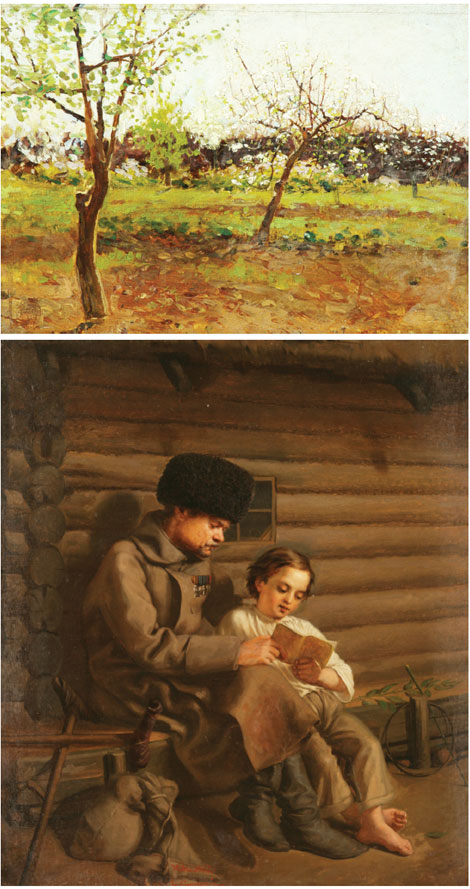Expressing the beauty and soul of belarus
An exhibition of paintings from the National Art Museum of the Republic of Belarus is now on display at the National Art Museum of China. Lin Qi reports.
The tranquil landscape of Belarus and the artists nurtured by this landlocked country are little-known to most Chinese people.
But as the Eastern European country strengthens its ties with China with the Belt and Road Initiative, more Belarusian artworks have been introduced to Chinese audiences at several exhibitions held in Beijing this year.
An exhibition of 57 paintings from the collection of the National Art Museum of the Republic of Belarus is now being held at the National Art Museum of China.
|
Paintings loaned from Belarus' national art museum, including Issac Levitan's The Alps (top) and Nikodim Silvanovich's Soldier with a Boy (above), on show in Beijing. Photos Provided to China Daily |
The Beijing museum also staged another Belarusian art exhibition that concluded recently. It showed sculptures and watercolors by Sergei Selikhanov (1917-76) inspired by a visit to China in 1956. They were shown in China for the first time, and they were juxtaposed with the works of Konstantin Selikhanov, 50, Sergei's grandson, who is a sculptor in Minsk.
In June, Tsinghua University Art Museum presented Nonlinear Reality, an exhibition of Belarusian lithographs, watercolors and drawings on loan from the country's National Center of Modern Arts.
Speaking about this show, the center's director, Natalia Sharangovich, says no one is better than an artist at expressing a country's beauty and soul.
It is the same idea that is demonstrated at the current exhibition at the National Art Museum of China, which also celebrates the 25th anniversary of the establishment of Sino-Belarusian diplomatic ties this year.
The exhibition took two years to prepare, says Wu Weishan, director of the museum, and it is grounded in the variety of collections, from historical iconographies to modern works, at the National Art Museum of the Republic of Belarus.
Wu says the exhibition traces the evolution of Belarusian art since the 19th century to the present day, with a selection of portraits, landscapes, still lifes and genre paintings that "hail the majestic expanses and clear, blue sky of the land and its people's desire for a peaceful, free life".
The exhibition starts with the paintings of 19th-century Russian artists largely belonging to the artists' collective Peredvizhniki, or The Wanderers.
Uladzimir Prakaptsou, general director of the Belarusian museum, says that after Belarus was merged into the territory of the Russian Empire in the 18th century, many Belarusian artists were nourished by Russian art, and some received training in Moscow or St. Petersburg.
Among the Russian masters featured are Ilya Repin and Valentin Serov, two portrait artists, and Ivan Shiskin and Issac Levitan - both of whom are known for their realistic depiction of Russian landscapes.
Paintings of the four artists from the collection of Moscow's State Tretyakov Gallery were shown at an exhibition on the Peredvizhniki group of artists at the National Museum of China in 2015.
Their influence on Belarusian painters is examined in the show through the works of Ivan Khrustsky, a still life master, and Stanislau Zhukousky, an outstanding painter of landscapes.
Belarusian artworks of the second half of the 20th century constitute the bulk of the treasure trove of the National Art Museum of the Republic of Belarus and number more than 15,000, says general director Prakaptsou.
He says the current exhibition features representative artists who established the national art school of painting in Belarus at the time.
He says their productions focus on the life and work of ordinary people after World War II, including how people reconstructed the war-torn capital city, Minsk.
He adds that the 1960s also saw a boost of Beralusian landscapes in which one can "feel a love of the country, a sentimental mood, an excellent arrangement of colors and a revealing of people's mental being in the depiction of daily scenes".
Belarus declared independence in 1991 during the dissolution of the Soviet Union.
Prakaptsou says contemporary artists have sought a national cultural identity, and they take great interest in the origin and traditions of ethnic Belarus culture.
The paintings on display of Mikalai Seliashchuk and Vasil Kastiuchenka, for example, take their inspiration from the country's folk tales, festivals and fables.
Contact the writer at linqi@chinadaily.com.cn



















